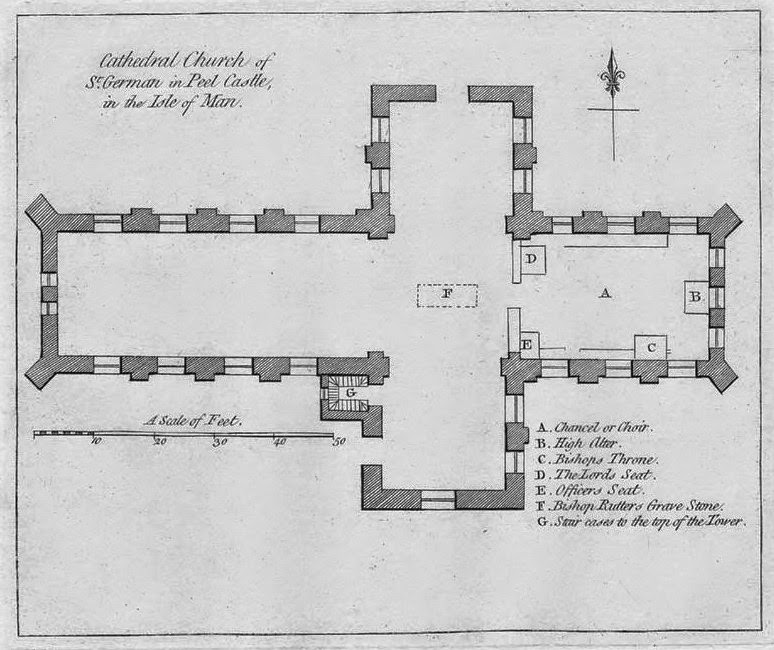PEEL CASTLE c.1659

Pre-amble
Well, this was an odd and interesting project for me, as i remember well working in the Isle of Mann back in the early 90s as a student. The kind of life experience building exercise you engage when your younger, but would rather not re-live if you could manage it. I remember leaving the island on a plane and swearing i'd never be back.
Introduction
When Dr. John Callow called me up to discuss doing artwork for an article on Peel Castle, i was quite surprised, because i had lived beside the castle for a summer and had trudged around it many times.
After sending a synopsis of the scenario, reference photos/images and the historical context. I couldnt refuse him, considering my experience of the place. Its was a period i hadn't done much work on (the end of the English Commonwealth) and a place i hadnt done any work on at all.
The Castle
http://en.wikipedia.org/wiki/Peel_Castle
Peel Castle has an ancient history, perched on St. Patrick's Island, in the modern town of Peel (see link), unfortunately the Wikilink doesn't discuss much of the ECW history. The Commonwealth Newsbook states
"This castle of Peel is a very strong and considerable place, seated upon a rock in the sea, and not accessible by land, save only some few hours at low water"
and the Daniel King engravings show a fully functioning fortress, which fell into disrepair in the 1690s when the roofs were removed.
 |
| looking towards the Battery, St Germain's & Peel harbour |
During the civil war the castle was modernised, with the addition of the earth fort and the half moon battery which was attached to the ecclesiastical buildings, Dr. Callow informed me this was "crucial in routing the native Manx" when they tried to take the castle in 1651. They stormed the gatehouse but then got raked in flanking fire from the loop-holed walls and retreated
| Commonwealth colour http://www.crwflags.com/fotw/images/g/gb_cmnwth-stdd.jpg |
The Demi-lune and St. Germain
These images taken from various online sources and used here as merely illustrative of the structures. There was an extensive archaeological survey and dig carried out, which has been published.
The Half Moon (demi-lune) Battery was built at the latter end of the Castles use and was used during the period we cover here - with St. German's behind. There is a loop holed structure connecting both the Demi-lune and St Germain, St. Patrick's chapel and the later armoury.
The flag flying - in November to December 1659 - would have been the Commonwealth Arms - the 2 shields of, respectively, the cross of St. George and the Irish Harp.
Here is a description of Manx costume, written by William Blundell in the 1650s -
"... the women of the Island of Man going abroad they gird themselves about with their winding sheet ... I met many so clothed in the Island I confess, and I questioned many of them to know the reason why they did wear them; all answered me that they had no other intention but to keep themselves from the cold and from the bleake and boisterous weather and winds which indeed do much molest them all the winter months ...
in the Island they are called neither sheets nor shrouds, but are called blankets. These blankets there worn are as well of woollen as of linen cloth (yea the better sort of them in the country have one blanket for Sundays, another for working days, but all shrouds are of linen ...
I confidently believe the Manks women took up this custom of wearing blankets from the Irish, their old ancestors and near neighbours, who ever did and do wear mantles ..."
Setting the Scene
In the early hours of the morning Governor Chaloner bedchamber door is broken down by soldiers under Lietenant Hathorne of Peel Castle Garrison. He was dragged out of bed in his nightshirt and night cap and brought forthwidth to Peel Castle.
 |
| basic initial drawing of the scene near the half moon battery |
He was a forthright, and forceful individual. His entire life was forged through the crucible of the Civil Wars - he first appears as an Ensign at the storm of Berkeley Castle in 1645; and undoubtedly served at Naseby. He seems to have been involved in the taking of Man in 1651 and in the taking of Royalist/Irish privateers in 1651-52-53. He ended up as a Quaker and was very close to the Wallingford House circle of officers & the Committee of Public Safety in 1659.
His daughter - in her red skirt - needs to be in the picture, too. She would have been about 8 at the time. She is a major figure in my article - so I'd like her to be an active and attractive figure, here. (I see her as having bright, intelligent eyes - and her fair haired). The article hangs on him and his character as a professional soldier. Also give him a grey / white riding cloak draped over his armour, that would fit with the inventory of his goods."
Dr. John
Callow
 |
| unfinished version of painting |
I was fortunate enough to have had a willing model Leah Mc Mennamin who posed for the figure of the Hathorne girl, John was one of the soldier and Sean McMennamin was the halberd yielding sergeant, this made the job of creating the scene a lot easier.
1650-60 in contemporary artwork
| Humphrey Chetham cap |
Sketches & studies













































Comments
Post a Comment